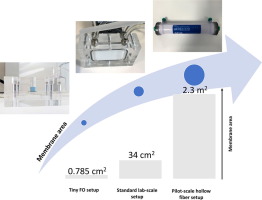Separation and Purification Technology ( IF 8.1 ) Pub Date : 2020-01-24 , DOI: 10.1016/j.seppur.2020.116616 Mahdi Nikbakht Fini , Henrik Tækker Madsen , Jens Laurids Sørensen , Jens Muff

|
Often FO experiments are carried out with the prevalent FO lab-scale setup using a moderate-sized flat sheet membrane. This necessitates spending funds on providing FO apparatuses and using higher area of FO membranes associated with a larger amount of chemicals to evaluate the performance of the FO process in rejection of compounds of interest. In this paper, we used two different FO setups, a typical lab-scale system using flat sheet aquaporin membrane as well as a small pilot-scale setup using hollow fiber aquaporin membrane, to remove three pesticides from water: 2-6 Dichloro-benzamide (BAM), 2-methyl-4-chlorophenoxyaceticacid (MCPA), and 2-(4-Chloro-2-methylphenoxy)propionic acid (MCPP). The obtained rejection data of BAM was compared to our previous study on aquaporin FO membrane using a tiny FO system to investigate the effect of going from a tiny lab-scale to a pilot-scale setup. The diffusion-controlled rejection of BAM was found to be 93-94% using the standard lab-scale flat sheet membrane system while that was 98.7% using the pilot-scale hollow fiber membrane which is in accordance to our preliminary result of >97% with the tiny system. This study confirms the hypothesis that we can employ a very small piece of membrane and accurately use it to estimate the rejection performance of a pilot-scale FO membrane system. This finding allows for a cost-effective and quick test of a large number of molecules by most importantly, the use of a tiny piece of FO membrane. Moreover, both systems, in particular, the hollow fiber setup demonstrated an excellent rejection capability for the charged phenoxy acid herbicides by having rejection values of 99.2% for both MCPA and MCPP.
中文翻译:

使用水通道蛋白膜将正渗透作用从实验室规模扩展到中试规模,以去除农药
通常,FO实验是使用中等大小的平板膜在FO实验室规模进行的普遍设置下进行的。这就需要花费资金来提供FO设备和使用更大面积的FO膜以及更多的化学物质来评估FO工艺在排除目标化合物方面的性能。在本文中,我们使用了两种不同的FO设置,即使用平板水通道蛋白膜的典型实验室规模系统和使用中空纤维水通道蛋白膜的中试规模设置,以从水中去除三种农药:2-6二氯苯甲酰胺(BAM),2-甲基-4-氯苯氧基乙酸(MCPA)和2-(4-氯-2-甲基苯氧基)丙酸(MCPP)。使用微型FO系统将获得的BAM排斥数据与我们先前对水通道蛋白FO膜的研究进行比较,以研究从微型实验室规模过渡到中试规模设置的效果。使用标准实验室规模的平板膜系统,发现BAM的扩散控制排斥率为93-94%,而使用中试规模的中空纤维膜则为98.7%,这与我们初步结果> 97%小系统。这项研究证实了以下假设:我们可以使用一块很小的膜,并准确地使用它来估算中试规模FO膜系统的抑制性能。最重要的是,使用一小块FO膜,这一发现就可以对大量分子进行具有成本效益的快速测试。而且,特别是两个系统











































 京公网安备 11010802027423号
京公网安备 11010802027423号